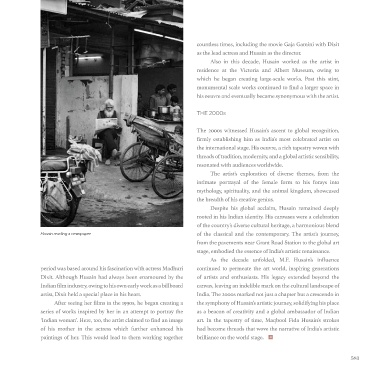Page 583 - M F Husain The Eternal Master
P. 583
him further into the spotlight encouraging more public countless times, including the movie Gaja Gamini with Dixit
performances of his works. as the lead actress and Husain as the director.
As he walked the streets of Calcutta, he came upon the Also in this decade, Husain worked as the artist in
figure of Mother Teresa and was indelibly impacted by her residence at the Victoria and Albert Museum, owing to
image and the compassion she displayed in her work with which he began creating large-scale works. Post this stint,
the vulnerable sections of society. In 1980, he created his first monumental scale works continued to find a larger space in
portrait of her after she won both the Bharat Ratna award his oeuvre and eventually became synonymous with the artist.
and the Nobel Peace Prize. This was the start of an incredibly
important series of works for Husain that would be perfected THE 2000s
through the decades.
The seminal British Raj series was executed late into the The 2000s witnessed Husain’s ascent to global recognition,
1980s, inspired by the artist’s own life growing up in colonial firmly establishing him as India’s most celebrated artist on
India. His interest in depicting British colonialism through the international stage. His oeuvre, a rich tapestry woven with
his unique visual language was portrayed through characters threads of tradition, modernity, and a global artistic sensibility,
such as British officials alongside Indian nobility. These resonated with audiences worldwide.
works were not only critical in nature but also highlighted the The artist’s exploration of diverse themes, from the
marred relationship between the colonists and the colonised. intimate portrayal of the female form to his forays into
The series, hence, was an unmissable contribution to Modern mythology, spirituality, and the animal kingdom, showcased
Indian Art history. the breadth of his creative genius.
Husain sketching in a restaurant Despite his global acclaim, Husain remained deeply
THE 1990s rooted in his Indian identity. His canvases were a celebration
of the country’s diverse cultural heritage, a harmonious blend
The Mother Teresa series was one of Husain’s greatest works Husain reading a newspaper of the classical and the contemporary. The artist’s journey,
Through Human Space’ gained him much renown among during the 1990s. Although he first began creating works from the pavements near Grant Road Station to the global art
peers and appreciators alike. The series showcased his featuring her in the 1980s, he perfected her form in his visual stage, embodied the essence of India’s artistic renaissance.
preoccupation with painting the human condition and the syntax in the following decade. She often appeared feature- As the decade unfolded, M.F. Husain’s influence
suffering that comes with it. Vishwamitra, executed in 1973, less, surrounded by the people she worked with and dressed period was based around his fascination with actress Madhuri continued to permeate the art world, inspiring generations
too, was a landmark work for this decade. in her white sari with blue border. This series also signalled Dixit. Although Husain had always been enamoured by the of artists and enthusiasts. His legacy extended beyond the
Husain’s interest in motherhood and translating his thoughts Indian film industry, owing to his own early work as a billboard canvas, leaving an indelible mark on the cultural landscape of
THE 1980s on the subject onto his canvases, using Mother Teresa as the artist, Dixit held a special place in his heart. India. The 2000s marked not just a chapter but a crescendo in
recurring motif. Having lost his mother at a young age, Husain After seeing her films in the 1990s, he began creating a the symphony of Husain’s artistic journey, solidifying his place
For Husain, the 1980s brought with it a newfound stardom claimed that he could not remember his mother’s face. This series of works inspired by her in an attempt to portray the as a beacon of creativity and a global ambassador of Indian
albeit controversial. He shot to the limelight with exhibitions would find expression in his Mother Teresa figure who was ‘Indian woman’. Here, too, the artist claimed to find an image art. In the tapestry of time, Maqbool Fida Husain’s strokes
and paintings finding space in national dailies regularly. pictured face-less and often surrounded by children. of his mother in the actress which further enhanced his had become threads that wove the narrative of India’s artistic
Soon after, he began walking barefoot, a trait that catapulted One of his other iconic series to emerge from this time paintings of her. This would lead to them working together brilliance on the world stage.
580 581

